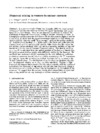Identificador persistente para citar o vincular este elemento:
https://accedacris.ulpgc.es/jspui/handle/10553/77762
| Campo DC | Valor | idioma |
|---|---|---|
| dc.contributor.author | Pelegrí Llopart,José Luis | en_US |
| dc.contributor.author | Csanady, T. | en_US |
| dc.date.accessioned | 2021-02-17T12:18:35Z | - |
| dc.date.available | 2021-02-17T12:18:35Z | - |
| dc.date.issued | 1994 | en_US |
| dc.identifier.issn | 0148-022 | en_US |
| dc.identifier.uri | https://accedacris.ulpgc.es/handle/10553/77762 | - |
| dc.description.abstract | In a previous study (Pelegrí and Csanady, 1991) we found upward entrainment and two-way exchange between the upper thermocline and surface layers of the Gulf Stream. Here we use isopycnic coordinates to analyze the mechanism of diapycnal shear-induced mixing in western boundary currents. A hydrographic section across the Gulf Stream off the Mid-Atlantic Bight is used for a case study. It shows that the upper thermocline layers of the Gulf Stream are characterized by relatively small (16 m averaged) gradient Rlchardson numbers, Ri. Analysis of the Jacobian, J = {)z/{)p (with z the depth and p the potential density), total vorticity and potential vorticity fields shows that this region has low Jacobian values associated with high values of potential vorticity, as required theoretically for the case of dominant diapycnal mixing. The density tendency, wp = Dp/ Dt, is calculated from the vertical gradient of the Reynolds density flux, the latter parameterized as density eddy diffusivity divided by the Jacobian. We use Munk and Anderson's (1948) expression for the eddy diffusivity coefficient, modified to conform to data of Ueda et al. (1981), maintaining a Ri-312 dependence for large Ri. From this we obtain an explicit expression for Wp in terms of the Ri and J distributions. The distributions of wp, its diapycnal gradient, awp/{)p, and the diapycnal velocity, Wd = Jwp, are then calculated. Regions of high diapycnal convergence (large negative {)wp/{)p values) coincide with the location of anomalously low Jacobians, in agreement with the idea that diapycnal mixing is the consequence of anomalies produced during frontogenesis in sorne phase of the meanders. We suggest that this process, taking place intermittently in space and time, is responsible for two-way exchange in western boundary currents. | en_US |
| dc.language | eng | en_US |
| dc.relation.ispartof | Journal of geophysical research. Oceans | en_US |
| dc.source | Journal of geophysical research [ISSN 0148-0227], v. 99 (C9), p. 18.275-18.304 | en_US |
| dc.subject | 2510 Oceanografía | en_US |
| dc.title | Diapycnal mixing in western boundary currents | en_US |
| dc.type | info:eu-repo/semantics/article | - |
| dc.type | Article | - |
| dc.description.lastpage | 18.304 | en_US |
| dc.description.firstpage | 18.275 | en_US |
| dc.relation.volume | 99 | en_US |
| dc.investigacion | Ciencias | en_US |
| dc.type2 | Artículo | - |
| dc.description.numberofpages | 30 | en_US |
| dc.identifier.ulpgc | No | en_US |
| dc.contributor.buulpgc | BU-BAS | en_US |
| item.fulltext | Con texto completo | - |
| item.grantfulltext | open | - |
| crisitem.author.fullName | Pelegrí Llopart, José Luis | - |
| Colección: | Artículos | |
Visitas
43
actualizado el 11-ene-2026
Descargas
81
actualizado el 11-ene-2026
Google ScholarTM
Verifica
Comparte
Exporta metadatos
Los elementos en ULPGC accedaCRIS están protegidos por derechos de autor con todos los derechos reservados, a menos que se indique lo contrario.
